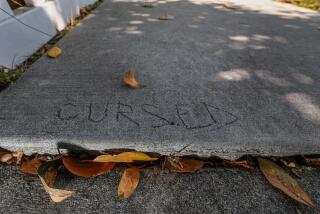Power washing is a dirty job, but could help contain San Diego’s hepatitis A outbreak

- Share via
Reporting from San Diego — More than a few people took a second look at the trucks with flashing lights and men in hazmat suits spraying chemicals on sidewalks in several San Diego neighborhoods Friday.
“Is it OK if I go through?” one man asked as he stopped before stepping on the wet sidewalk in the Midway area.
He was told it was fine, despite the slight smell of bleach that arose as the wet sidewalk heated up around 8 a.m. on Rosecrans Street.
It was unclear whether he knew the crew he passed was spraying sidewalks because they might have, among other things, traces of human feces that could contain a deadly virus.
“That’s urine,” one of the crew members said just after the pedestrian passed, pointing out a telltale white foam that emerged as the chemicals lingered on a sidewalk in front of a bus stop.
Needless to say, it’s not the most glamorous job. But it is a job that has brought the new national attention to the effort to help contain a hepatitis A outbreak that has left 17 dead and hundreds hospitalized.
ABC News, CNN, Newsweek and the Washington Post have reported on the effort to stop the deadly outbreak, and a team from the HBO newsmagazine “Vice” followed the crew as it walked down Rosecrans Street on Friday.
The hepatitis A virus is spread through fecal matter, and homeless people are particularly vulnerable because they have limited access to toilets and places to wash their hands.
To fight the spread, the city has set up public toilets and hand-washing stations downtown and removed people from large sidewalk encampments. On Friday, city crews also moved homeless people out of campsites along the San Diego River.
Clearing away unsanitary tents was one step in stopping the spread of the disease, but the virus still may be on sidewalks, embedded, unseen and dangerous if picked up on a shoe that’s later touched.
On Sept. 11, Clean Harbors Environmental Services began cleaning sidewalks with chemicals downtown, and this week they expanded to Ocean Beach, Pacific Beach and the Midway area. On Friday, they finished in Midway and moved on to North Park, Park Boulevard and Colina Park.
“Although the city has had limited sanitizing efforts in the past, the current sidewalk sanitizing work is the largest scale, widespread project of its kind for us,” said Mario Sierra, director of the city’s Environmental Services Department. “Public safety and public health must be prioritized, and I’m confident that sanitizing work is making a difference.”
More to Read
Sign up for Essential California
The most important California stories and recommendations in your inbox every morning.
You may occasionally receive promotional content from the Los Angeles Times.










